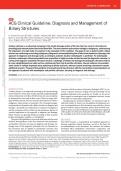Overig
405 ACG Clinical Guideline: Diagnosis and Management of Biliary Strictures B. Joseph Elmunzer, MD, MSc1 , Jennifer L. Maranki, MD, MSc2 , Victoria Gomez, MD ´ 3 , Anna Tavakkoli, MD, MSc4,5 , Bryan G. Sauer, MD, MSc, FACG6 , Berkeley N. Limketkai, MD, Ph
- Vak
- Instelling
405 ACG Clinical Guideline: Diagnosis and Management of Biliary Strictures B. Joseph Elmunzer, MD, MSc1 , Jennifer L. Maranki, MD, MSc2 , Victoria Gomez, MD ´ 3 , Anna Tavakkoli, MD, MSc4,5 , Bryan G. Sauer, MD, MSc, FACG6 , Berkeley N. Limketkai, MD, PhD, FACG7 , Emily A. Brennan, MLIS8 ...
[Meer zien]




